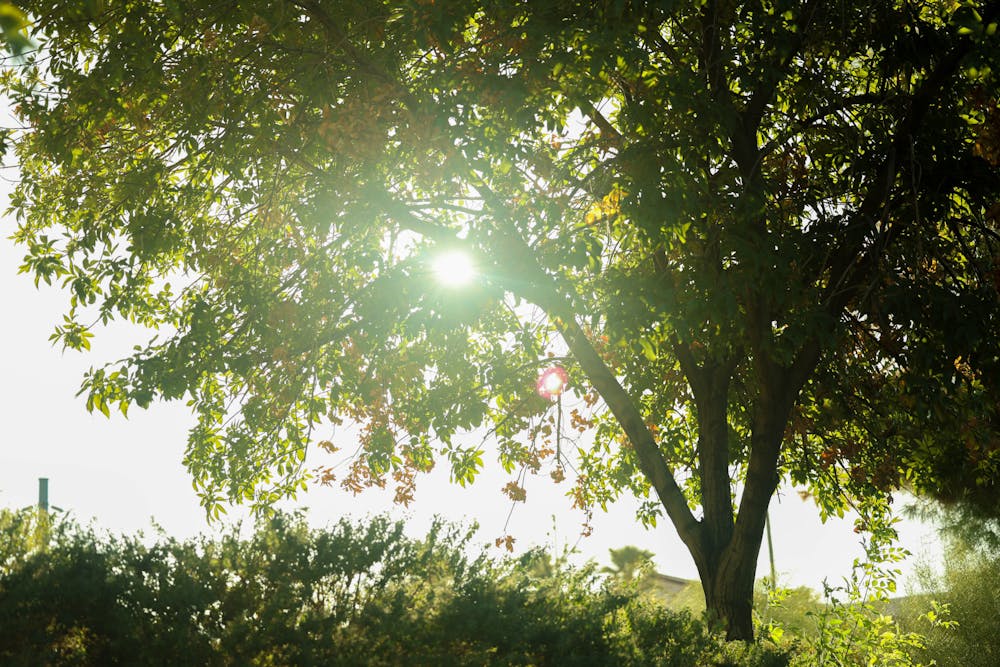It’s November — a signal to me that it’s almost the end of the year.
Normally, a November for me would be cold, a month of constant sweatshirts and jackets, a time to see orange and yellow leaves outside that slowly fade into dead trees without branches. November would be the start to a collective seasonal depression among me and my friends: more tests, less daylight and a grayer atmosphere.
But this November is a little different. It’s warm outside, barely requiring me to wear any layers. It’s green outside, and the trees aren’t exactly shedding leaves. And it’s sunny, signaling a continuous happiness with life as opposed to a depression.
I’m from Louisville, Kentucky — a place that has vibrant autumn colors and a fall aura. Halloween is typically chilly, and November begins the start of the cold fall-winter season. But living in Tempe, Arizona has changed what fall means to me.
It doesn’t mean cold mornings or autumnal-colored evenings. And most importantly, it doesn't mean the start of a seasonal depression.
Seasonal depression, or seasonal affective disorder, is a type of depression that happens during a specific part of the year, which ends up naturally reducing the amount of certain chemicals your brain produces, resulting in depression-like symptoms.
Although seasonal depression affects only 5% of the U.S. adult population, it is a relatively common experience to feel less energetic or a prolonged sadness due to less daylight during the fall and winter time.
In Arizona, seasonal depression doesn't affect most citizens in the fall and winter seasons, but rather in the summer. Because of the excessive heat Arizonans face, being cooped up indoors during the summer often causes depression-like symptoms as well.
Especially with daylight savings time in most of the country, fall and winter months have earlier sunrises and sunsets, meaning less bright time outside.
But in Arizona, a state that does not observe daylight savings, there are no "earlier" sunsets and sunrises in the fall and winter. It shifts back and forth within a given hour, but doesn't cause a dramatic change in the amount of daylight. As a person who has experienced a drastic change in daylight living in Kentucky, not observing daylight savings doesn't mean "less" daylight, but a similar amount in November and December.
And because of this, I don’t feel as if November is a month that is so full of complacency anymore. It’s a month that’s still full of blossoming change, and a month that may be the end of the academic semester, but the start of a new beginning of looking forward to winter.
It’s a weird feeling — one that's bittersweet, because it almost contradicts what I’ve grown accustomed to during the late fall months.
Although the term "seasonal depression" is often used casually, the disorder is a legitimate reason to feel moody, less energetic and overall less happy during the later months. There are many treatments for seasonal depression, some of which include light therapy, as well as physical exercise and/or antidepressants. In any case, it's important to talk to a doctor or therapist about different treatment options to figure out which is best for you when dealing with seasonal depression.
Although I enjoy the November I have to look forward to, I go back to Kentucky for December, meaning that I will experience the effects of prolonged darkness myself. But it will be different this year — I have January and February to look forward to in Arizona, among the sunshine and daylight. The temperature might get colder, but a change of scenery never hurts.
Edited by Claire van Doren, Sadie Buggle and Caera Learmonth.
Reach the reporter at gachatht@asu.edu.
Like The State Press on Facebook and follow @statepress on X.
Gokul is a sophomore studying actuarial science. This is his fourth semester with The State Press.




